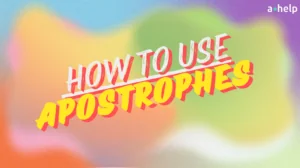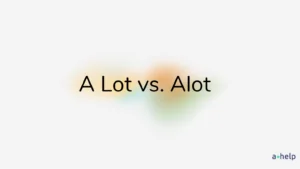The English language is full of small words that can make a big difference in meaning, and two such words are “that” and “which.” To put it (very) simply, “that” is used when providing key information to the sentence, and “which” is used when adding extra, non-essential details. This article aims to shed light on the distinction between “that” and “which,” focusing on their roles in sentences and use cases. Whether you’re a student, a professional, or just someone looking to improve your English skills, mastering the use of “that” and “which” is the basic rule to know.

✅ AI Essay Writer ✅ AI Detector ✅ Plagchecker ✅ Paraphraser
✅ Summarizer ✅ Citation Generator
Using ‘That’
When we use the word “that” in a sentence, we’re usually dealing with what’s called a restrictive clause. This type of clause is crucial because it gives us important information that we need to understand the sentence fully. Think of it as the part of the sentence that you can’t get rid of without changing its meaning.
For example, consider the sentence:
“The book that is on the table is mine.”
Here, “that is on the table” is a restrictive clause. It tells us exactly which book we’re talking about – the one on the table. If we took out this clause, we’d be left with “The book is mine,” which is much vaguer. We wouldn’t know which book the speaker is referring to.
Here are a few more examples to help you get the hang of using “that” in restrictive clauses:
“The cake that my mom made tastes delicious.”
“I can’t find the pen that I was using yesterday.”
“The movie that we watched last night was really scary.”
In each of these sentences, the part after “that” is essential to understanding which cake, pen, or movie is being talked about. So, when you’re writing and you need to specify something important, remember to use “that” to introduce your restrictive clause or turn to a free grammar checker online.
Using ‘Which’
The word “which” is often used in sentences to introduce what we call a nonrestrictive clause. Unlike restrictive clauses, nonrestrictive clauses give us extra information that’s nice to know but not essential for understanding the main point of the sentence. We usually set these clauses apart with commas to show that they’re adding bonus details.
For example, take the sentence:
“My bicycle, which has a blue frame, is parked outside.”
Here, “which has a blue frame” is a nonrestrictive clause. It gives us additional information about the bicycle, but it’s not crucial for understanding the sentence. Even if we remove this clause, the main idea that “My bicycle is parked outside” remains clear.
Here are a few more examples to illustrate the use of “which” in nonrestrictive clauses:
“The library, which was built in the 19th century, is a historic landmark.”
“My favorite book, which I’ve read multiple times, is ‘To Kill a Mockingbird.'”
“The cake, which was decorated with fresh flowers, looked beautiful.”
In each of these sentences, the information after “which” adds extra details but isn’t necessary to grasp the main point. So, when you want to include additional information that can be skipped without losing the essence of your sentence, use “which” with commas to introduce your nonrestrictive clause.
Common Mistakes and Misconceptions
When it comes to using “that” and “which,” there are some common mistakes and misconceptions that can lead to confusion. Understanding these can help you use these words correctly and improve your writing.
🚫 Using “Which” Instead of “That” in Restrictive Clauses
One common error is using “which” instead of “that” in restrictive clauses. For example, saying “The book which is on the table is mine” is incorrect. It should be “The book that is on the table is mine.” Remember, “that” is used for essential information, while “which” is used for extra details.
💭 Forgetting to Use Commas with “Which” in Nonrestrictive Clauses
Another mistake is forgetting to use commas with “which” in nonrestrictive clauses. For example, “My bike which has a blue frame is parked outside” is incorrect. It should be “My bike, which has a blue frame, is parked outside.” The commas help to set apart the extra information.
🔁 Thinking “That” and “Which” Are Interchangeable
A common misconception is that “that” and “which” can always be used interchangeably. This is not true. They have specific roles in sentences, as we’ve seen with restrictive and nonrestrictive clauses.
👩💼 Believing “Which” Sounds More Formal Than “That”
Lastly, some people think that “which” sounds more formal or sophisticated than “that.” This is not necessarily the case. The choice between “that” and “which” should be based on the structure of the sentence, not on a desire to sound more formal.
By keeping these points in mind, you can avoid common errors and use “that” and “which” correctly in your writing.
That vs. Which Exercises
Now, that you feel a little bit more confident about using “which” and “that” in sentences, let’s do some exercises to really lock in the progress. below, you can also find the answers to each exercise. No peeking!
Exercise 1
Choose the correct word (that or which) to complete each sentence:
- The book _____ is on the table is mine.
- My bicycle, _____ has a blue frame, is parked outside.
- The cake _____ my mom made tastes delicious.
- The library, _____ was built in the 19th century, is a historic landmark.
- I can’t find the pen _____ I was using yesterday.
Exercise 2
Correct the following sentences if necessary:
- The car which I bought last year is already having problems.
- My favorite movie, that won several awards, is being shown on TV tonight.
- The house that has a red door belongs to my aunt.
- The painting, which was stolen last year, has been recovered.
- She gave me the letter that was sealed in an envelope.
Exercise 3
Add commas to the following sentences where needed:
- The book which was lying on the table is now missing.
- My laptop that I bought last month is already outdated.
- The museum which is located downtown is closed on Mondays.
- His advice which he gave me was very helpful.
- The flowers that are blooming in the garden are beautiful.
In summary, the choice between “that” and “which” is a crucial aspect of English grammar that can significantly impact the clarity of your writing. By recognizing the difference between restrictive and nonrestrictive clauses, you can use “that” and “which” correctly and confidently. Remember, “that” is used for essential information, while “which” is used for additional details. With practice and attention to detail, you can master this distinction and enhance your communication skills. So, the next time you write, take a moment to consider whether “that” or “which” is the right choice for your sentence.
FAQ
Follow us on Reddit for more insights and updates.





Comments (0)
Welcome to A*Help comments!
We’re all about debate and discussion at A*Help.
We value the diverse opinions of users, so you may find points of view that you don’t agree with. And that’s cool. However, there are certain things we’re not OK with: attempts to manipulate our data in any way, for example, or the posting of discriminative, offensive, hateful, or disparaging material.